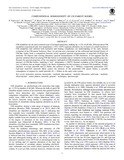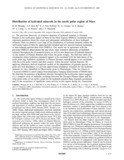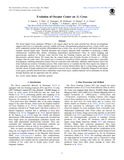Browsing by Author "Cloutis, E. A."
Now showing items 1-3 of 3
-
Compositional homogeneity of CM parent bodies.
Vernazza, P.; Marsset, M.; Beck, P.; Binzel, R. P.; Birlan, M.; Cloutis, E. A.; DeMeo, F. E.; Dumas, C.; Hiroi, T. (The Astronomical Journal, 2016-08-10)CM chondrites are the most common type of hydrated meteorites, making up ∼1.5% of all falls. Whereas most CM chondrites experienced only low-temperature (∼0°C–120°C) aqueous alteration, the existence of a small fraction ... -
Distribution of hydrated minerals in the north polar region of Mars
Horgan, B. H.; Bell, J. F. III; Noe Dobrea, E. Z.; Cloutis, E. A.; Bailey, D. T.; Craig, M. A.; Roach, L. H.; Mustard, J. F. (Journal of Geophysical Research, 2009-01-28)The previous discovery of extensive deposits of hydrated minerals in Olympia Planum in the north polar region of Mars by the Mars Express OMEGA instrument raises important questions about the origin and subsequent ... -
Evolution of Occator Crater on (1) Ceres
Nathues, A.; Platz, T.; Thangjam, G.; Hoffmann, M.; Mengel, K.; Cloutis, E. A.; Le Corre, L.; Reddy, V.; Kallisch, J.; D. A. Crown, D. A. (The Astronomical Journal, 2017-02-17)The dwarf planet Ceres (diameter 939 km) is the largest object in the main asteroid belt. Recent investigations suggest that Ceres is a thermally evolved, volatile-rich body with potential geological activity, a body which ...



